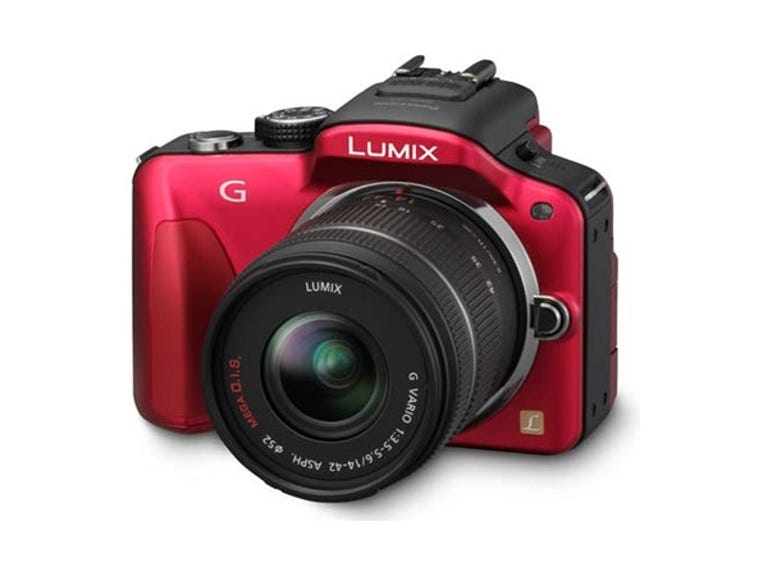 Why You Can Trust CNET
Why You Can Trust CNET Panasonic Lumix DMC-G3 review: Panasonic Lumix DMC-G3
The G3 is a great addition to the already-strong range of Panasonic interchangeable lens cameras, with a few notable omissions holding it back from being top notch.
Design and features
As part of Panasonic's third generation of interchangeable lens cameras, the aptly titled G3 pulls together bits and pieces from older cameras in the range. It's not some sort of Frankenstein's monster, fortunately — instead the G3 improves on each previous camera it is inspired by. The first thing to notice is the body style, which looks like a love child between the GF2 and earlier G2 cameras. The prominent right-hand grip is now much more slender, and as a result a lot easier to hold for smaller hands. Overall, the form factor is smaller, too, shaving off vital centimetres where it counts, which includes reducing the faux-pentaprism hump over the lens.
The Good
The Bad
The Bottom Line
The G3 comes with an electronic viewfinder (EVF) as well as a 3-inch flip-out touchscreen. Unfortunately, there's no longer a sensor that automatically detects when the camera has been moved towards and away from your eye, switching between the EVF and LCD. There's a stereo mic on top of the camera, just in front of the hotshoe. However, this means that Panasonic hasn't included an external mic jack on the camera, so you'll have to rely on the in-built units.
Fortunately, the touchscreen has been refined from the version found on the earlier G2. It's much more responsive and has a few extra enjoyable features. Now, you can touch to focus on pretty much any part of the screen — even at the extreme edges. Pinpoint focus enlarges the portion of the image you want to focus on for more precise results. Never fear if touchscreen controls aren't your thing, though, as the G3 is also well endowed with physical buttons for the main controls. A PASM mode dial sits at the top of the camera, housing controls for some custom settings, as well as some picture effects and scene modes.
Inside, things look quite different, too. The sensor is a 16-megapixel Live MOS monster, which is similar but definitely not the same as the one found on the GH2. Panasonic also claims that the Light Speed AF system is able to seek and achieve focus within 0.1 second.
Connectivity is via a mini-HDMI port, mini-USB port and a remote port.
Compared to
| Olympus E-P3 | Panasonic Lumix G3 | Samsung NX11 | Sony NEX-5N |
|---|---|---|---|
| 12.3-megapixel Live MOS sensor (four-thirds type) | 16-megapixel Live MOS sensor (four-thirds type) | 14.6-megapixel CMOS sensor (APS-C size) | 16.1-megapixel Exmor HD CMOS sensor (APS-C size) |
| 3-inch, 610,000-dot touchscreen OLED | 3-inch, 460,000-dot touchscreen LCD | 3-inch, 920,000-dot AMOLED | 3-inch, 921,600-dot touchscreen LCD |
| Full HD video (1080i, 24fps) | Full HD video (1080i, 30fps) | HD video (720p, 30fps) | Full HD video (1080p, 25ps) |
| 35-point AF | 23-point AF | 15-point AF | 25-point AF |
| 3.2fps | 4fps | 3fps | 10fps |
Performance
Panasonic rates the battery at 270 shots. In super high burst mode (with Live View turned off), the G3 can capture 40 shots in 2.5 seconds using the electronic shutter, and images are captured at 4 megapixels. You may notice that in the comparison table above, the G3 can shoot 4fps — this is Panasonic's claim, and we unfortunately couldn't get our review camera to perform that quickly.
Image quality
The G3 produces some excellent images with the kit lens, and very clean JPEGs as well. Its image quality is the closest to SLR (and APS-C sensor size) quality we've seen so far from Micro Four Thirds cameras. Its images are far better than those produced on the G2 particularly at high ISO levels.
A comparison between images taken on the Canon EOS 600D and Panasonic G3, with 100 per cent crop inset.
(Credit: CBSi)
Colours are very pleasing on default settings, and plenty of photographers will enjoy the punchy, slightly over-saturated colours the G3 delivers. Exposure is accurate and automatic white balance when shooting JPEG also gets things right in the majority of situations, apart from a slight shift to more blue hues in outdoor and natural light. It's hardly noticeable, though. As the camera also comes with intelligent auto plus mode (iA+), you can easily adjust colours and other shooting parameters with easy sliders on the screen. This is on top of the photo filters such as expressive, high key and sepia that are built-in to the camera.
The detail able to be resolved by the 14-42mm lens is pretty good considering it's a kit lens, but there still are some elements of fringing and also subtle distortions visible. Most photographers won't find this an issue except when reviewing images at 100 per cent magnification.
Video quality is impressive, and users have the choice of shooting at 1080i (AVCHD) or 720p (Motion JPEG). You can set photo styles and adjust colours before shooting video. Quality is very good for a camera of this class, with decent sound from the built-in mics, but we would have liked a little more separation in place.
Image samples
Exposure: 1/125, f/3.5, ISO 160 | Exposure: 1/1300, f/3.5, ISO 160 |
Exposure: 1/250, f/6.3, ISO 160 | Exposure: 1/200, f/7.1, ISO 160 |
Conclusion
The G3 is a great addition to the already-strong range of Panasonic interchangeable lens cameras, with a few notable omissions holding it back from being top notch.
The G3 is available in black, red and white for AU$899 as body only, AU$1099 for the 14-42mm kit lens and AU$1399 for the twin-lens 14-42mm and 45-200mm kit.


